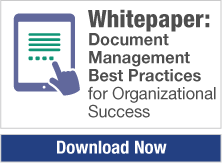Document Management Strategies
From Implementation Through Optimization
Implementing a document management system does not have to be a long drawn out process. It does not have to be hard or overly expensive. From our perspective, there are three key factors to a successful document management implementation:
- Establish a good working partnership with your document management vendor.
- The document management platform needs to be an easy-to-use tool and not a burden on your staff or financial resources.
- Don’t make it more complicated than it needs to be.
Let’s address each one separately and in detail.
 Establish a Good Working Partnership
Establish a Good Working Partnership
The first step in any document management implementation is analysis. This is true with any type of project. And as with any analysis, you need people who know the details of your business and people who understand the details of the technology. Typically, this means that your implementation team will have both your staff and your vendor’s staff working together to design the system.
Picking a vendor that you can rely on is a critical step in this process. In this case, not only must the vendor understand document management, but they need to be able to translate business requirements into an actionable plan, and create an effective document management strategy. However, it’s more complicated than that. The good vendors almost act as if they were detectives at a crime scene looking for clues as to what really happened. We’ve seen this time and again, companies don’t really pay attention to their business documents. When asked about a particular document, the answers are usually superficial. Your staff knows what the documents are and how they are used, but they don’t think about documents as much more than paper that is processed.
A document management vendor asks the following document management questions:
- What is the document?
- Who needs to see the document?
- What do you need to see on any given document?
- How do you find the documents?
- What other documents is this document related to?
- Does staff need to access other documents or systems when they look at this document?
- How is the document used?
- Does the document need to be approved?
- Does the document cause something to happen in the organization?
- How often is the document accessed?
- Does the document have a life cycle?
Your staff just does not think this way about documents. When asked, they will answer specific questions. This is one place where a document management vendor can truly make a difference. By asking not only the initial questions, but by following up with enough detailed questions, a document map can be established that shows where a document fits in the organization. It’s this detailed map that is used to create the storage structure, the retrieval paths, links to other documents or systems, the routing and approval paths, and even the retention schedule.
Document Management Implementations
Implementing document management requires detail oriented people to analyze the documents and the flow. What makes a partnership important is that even the most detail oriented people who act as document detectives will not find all the answers prior to implementing your system. Once the system is being prototyped, the remaining details tend to emerge. When you have a true partnership with your vendor, they not only anticipate this, but they work with you to make sure that the end result provides real benefits to your organization, not just an implementation of the latest technologies.
True partners not only learn your business, but they respond as if it is their own. This means that your implementation takes into account not just the way you do things today, but ways that you could enhance your document management strategy. Again, we’ve seen this over and over. Organizations follow procedures, sometimes unofficial rules, which have been in place for a long time. While the original reason for the procedures may have been long forgotten, the practices are still there. Many times the original reason is not even valid any more. When you have a partnership with a document management vendor, they not only find out what your current processes are, but they also look for ways to improve your processes and thus improve your efficiency.
To have a document management partnership, your vendor must specialize in document management strategy. That may seem like an obvious requirement; however, there are many different types of companies that sell document management as an add-on technology. These can be hardware vendors that sell copiers, scanners or multi-function machines. These can be resellers that sell many types of applications and may include a document management offering as part of their suite. In either case, while these vendors can implement basic document management, they cannot deliver the results that a true partner will deliver.
The last step in creating a document management partnership is to have a basic understanding of the technology they represent. While the vendor may be everything you want, the technology they implement should not be a burden on your staff or financial resources. The best way to ensure that the technology is not a burden is to implement your solution with a Software-as-a-Service architecture.




